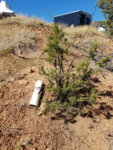I'll share what I know about California juniper... take it or leave depending on what you think applies.
Best time to collect for us is December when the tree is dormant. Given your winters, I would say best time to collect is early spring as soon as the ground is no longer frozen.
Success or failure depends on how many fine roots you can get. Because of where California juniper is found, it has a tendency to throw long running roots. If at all possible, dig up those roots even if they are far too long to eventually be used in bonsai. Get as much of the root mass as possible.
Try not to bare root it, even if you really want to

In a perfect world, you would collect the tree from a pocket of soil in rock, and be able to life the roots and the soil, en mass, and bring it all home together, where you could work on fixing the roots over a period of time.
Do not remove any foliage (in the case of junipers). It is critical to keep as much foliage as possible.
Bring a ton of water, a spray bottle, several crappy old towels, and lots of black lawn garbage bags. As soon as you lift the tree, wrap up the root ball in towels and soak the towels. Then place the entire tree in a plastic bag and spray all the foliage. It will be a soggy, muddy mess, but that's ok. Close the plastic bag so that it creates a humid air space while you take the tree home.
Once home do not work on the roots. Simply place the tree in an appropriate container (like an Anderson flat, or similar) and backfill the rootball with good inorganic mix.
The tree needs strong light to survive - but the foliage cannot dry out. The roots are compromised, so they cannot provide as much water as previously. Humidity is the key. If you don't have a greenhouse or cold frame, consider building a humidity tent. Even with a greenhouse, I know people who have misters on a timer and mist the foliage several times each day. Keep the foliage humid, let the roots recover, and when you see new growth on the foliage, you can start to reduce humidity and special care. Do not remove the tree from humidity care until it is showing strong growth (like 1" new growth extensions) and even then, protect from wind and dry conditions, while still providing plenty of light.[/QUOThan


